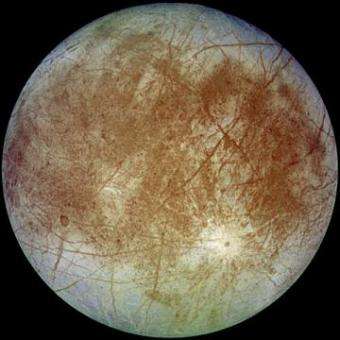Life on Europa? Scientists ponder the possibilities

When Galileo viewed Jupiter through his telescope in 1610, he saw four dim objects near it that he assumed were stars. Repeated observations revealed that these "stars" orbited Jupiter like our own moon circles Earth. Thus began over 400 years of observations of Jupiter's moons, which now number 67. But if experts who gathered Wednesday at NASA's Ames Research Center are successful, by midcentury we may see one of these moons in a whole new light.
More than 200 astronomers, physicists and astrobiologists from around the world debated how future missions to this moon, Europa, could search for signs of life. Their discussions were jovial and academic but also imbued with a sense of urgency as the space agency plans an upcoming mission to the white and rust-colored world. This icy moon had long been a candidate for extraterrestrial life.
But in December 2012, NASA's Hubble Space Telescope detected a probable plume of water and ice erupting over 120 miles above the surface near Europa's south pole, raising speculation that the moon may harbor a subterranean ocean that occasionally erupts to the surface. NASA officials are actively discussing additions to their spacecraft, the Europa Clipper, to investigate Europa's life-bearing abilities.
"We are going to do a Europa mission," said NASA Associate Administrator John Grunsfeld. "It's too good of a chance to miss."
Europa is only a little bit smaller than Earth's moon, but the similarities end there. It has a surface of ice and minerals, crisscrossed by dark streaks of material that scientists still do not fully understand. Beneath, many scientists believe frigid Europa harbors an ocean of water of unknown acidity or salinity. Deep in these seas, protected from harsh radiation on the surface, astronomers and biologists wonder if life could have evolved in its depths.
NASA intends to launch the Europa Clipper spacecraft around 2022, which could take over seven years to reach Jupiter. The mission, currently budgeted at $2.1 billion, would include repeated flybys of Europa to map the surface, learn more about its composition and study its interior, according to Dave Senske of NASA's Jet Propulsion Laboratory in Pasadena. Wednesday's discussions covered how the spacecraft's design could be modified to try to detect plume activity, sample a plume or search for signs of life on the distant world.
"Let's think outside of the box. Let's think in the box. Let's get some of the best ideas on the table," said Grunsfeld.
These ideas ranged from sending the Europa Clipper through a plume to collect samples to sending a small probe to the surface. One participant even proposed blowing a small hole in the crust and analyzing the material released. Since scientists do not definitively know how thick Europa's crust is, or its precise composition, their proposals had to take into account multiple uncertainties.
If the Europan ocean is a breadbasket for life, detecting it remotely on a spacecraft or surface probe will be no easy task. As repeated missions to Mars have shown, unmanned spacecraft or landers must harbor several expensive instruments to collect and analyze material for the presence of organic compounds. This task is made all the more difficult when participants pondered the possibility that extraterrestrial life might have a chemical composition very different from our own. The need for tests that are both broad and specific, on a spacecraft with limited room, poses a challenge to mission planners.
"I think if we had a camera and we saw a little guy walking across the lens, that would convince me," joked Patricia Beauchamp of JPL.
Taking samples from a plume could be a simple starting point, and pave the way for future missions. But, the Hubble Space Telescope only detected a possible plume once on Europa. Some experts at the meeting were adamant that this discovery must be confirmed before NASA devotes an entire mission to Europan plumes.
Today's deliberations will inform a growing body of astronomical work around sampling plumes and searching for life. In 2005, the Cassini spacecraft observed water-rich plumes erupting on Enceladus, one of Saturn's moons. This, coupled with continued interest in Europa and several other moons orbiting gas giants, kept spirits high and hopes pinned on new missions in the coming decades to search for signs of life in the outer solar system.
©2015 San Jose Mercury News (San Jose, Calif.)
Distributed by Tribune Content Agency, LLC





















